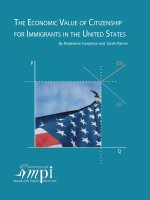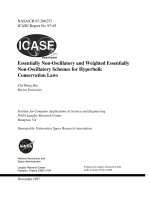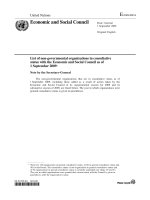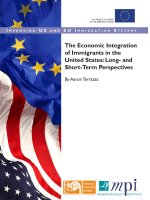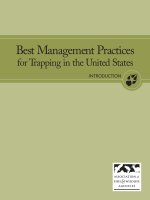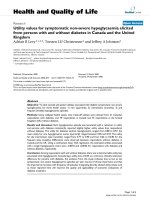Non commutative integration for uhf algebras with product state
Bạn đang xem bản rút gọn của tài liệu. Xem và tải ngay bản đầy đủ của tài liệu tại đây (2.64 MB, 7 trang )
<span class='text_page_counter'>(1)</span><div class='page_container' data-page=1>
VNU. JOURNAL OF SCIENCE, M athem atics - Physics. T .X X II, N ()l - 2006
N O N C O M M U T A T I V E I N T E G R A T I O N F O R
U H F A L G E B R A S W I T H P R O D U C T S T A T E
P h a n V i e t T h u
<i>Department o f Mathema tics-Mechanics and Informatics</i>
<i>Collecge o f Science, VN U</i>
<b>Abstract. Ill this paper we shall give a proof for a lem m a (L em m a 3) and a theorem </b>
(Theorem 3) stated ill the paper [2] of Goldstein, s. and Viet Thu, Phan published
ill International Journal of Theorenitical Physics vol. 37. <i>No.</i> 1. 1998 about the
construction of Lp spaces for UHF algebras. We shall also give cl proof for cl technical
theorem (Theorem 1), as a tool for the construction.
1. U n i f o r m ly m a t r i c i a l , U H F a lg e b r a s
A u n ital c * -alg eb ra A is called <i>un ifo r m ly ma tricial o f type</i> = 1, 2, ...,77-j £ N
when there exists a sequence {v4j}jeN ° f C *-subalgcbras of <i>A</i> and <i>a</i> sequence <i>{rij}</i> of
positive integers, such th a t for each <i>j</i> G <i>N , A j</i> is ^isom orphic to th e algebra A/Uj(C) of
<i>l i ị</i> X <i>U j</i> c o m p le x m a t r i c e s ,
1
<i>e Aị</i>c
<i>A 2</i>c
<i>A :i</i>c
and u <i>A j</i> is norm dense in <i>A .</i> T h e sequece is called a <i>g c n e m t i n g n e s t o f type</i>
<i>j € ^</i>
<i>[rij} for A. We shall also call it an approximating sequence for A. A uniformly matricial </i>
C '-a lg e b ra s <i>A</i> of typo <i>{rij}</i> exists iff th e sequence <i>{ n j }</i> is stric tly increasing and <i>Iij</i> divides
<i>rij+i’.V j</i> G N. M oreover w ith th ese conditions A is unique (up to iso m o rp h is m ) an d is a
sim ple algebra. T h e uniform ly m atricial algebras an d th e ir rep resen tatio n s are also called
<i>UHF algebras</i> (from th e term inology ’'u n ifo rm ly hyporfinite algebras” ). W hich can bí'
found ill <i><\</i> vast lite ratu re.
2. P r o d u c t s t a t e s [3]
Let <i>{ A j \ i</i> G <i>1}</i> be a fam ily of <i>c * -</i>algebras, <i>A = ® i e j A j</i> th e infinite ten so r product
of {.4,; <i>i</i> £ /} . and for each <i>i</i> G <i>I , Pi</i> a s ta te of <i>A (</i>i), th e canonical imago of <i>A ,</i> ill <i>A.</i> T hen
th<T(' is a unique* s ta te <i>p</i> of <i>A</i> such th a t
<i>(>{<11(12...(In) = Pi(l)(«l)/?i(</i>2)(n2)-P i(,o (« » ).
whore /’(1 ),..., <i>i(u)</i> arc* d istin ct elem ents of <i>I</i> and <i>(Ij</i> G i4(ị(j)); <i>j —</i> 1 , 2 Th e s ta te <i>()</i> is
(lonotod hy <i>®i€ỉỌj\</i> an d such s ta te s are called p ro d u c t s ta te s of G iven a product
<b>Typeset by ./4,VfiS-T^X</b>
</div>
<span class='text_page_counter'>(2)</span><div class='page_container' data-page=2>
<i><b>N o n C o m m u t a t i v e I n t e g r a t i o n f o r U H F Algebr as w i th P r o d u c t S t a t e</b></i> <b><sub>11</sub></b>
<i>state p. the component state Pi are uniquely determained, since Pi = p\A(i). The product </i>
<b>s ta te is p u re if a n d o n ly if each </b><i>P i</i><b> is pure and is tracial if and o n ly if each </b><i>P i</i><b> is tracial.</b>
3. T h e i n d u c t i v e l im it o f a d i r e c t e d s y s t e m o f B a n a c h s p a c e s
T h e o r e m 1<i>. Let { D f : f e F} be a family o f Banach spaces, in which the index set F is </i>
<i>(lilt'd('(I by </i> <i>Suppose that it f,cj £ F and f ^ g, there is an isometric linear mapping </i>
<i><Ị>g/ from D f onto D(J and $ k g $ g f — $ h f whenever f , g , h € F and f ^ g ^ h; then</i>
<i>(i). <Ị>// is the identity mapping on Df.</i>
<i>(ii). There is a Danach space D and for each / € F, an isometric linear mapping Uf</i>
<i>from </i> <i>D f into D. in such way that Uf = Ug$gf whenever f , g 6 F, / ^ g and u { Uf ( Df ) :</i>
<i>/ € F} is cvorywht'iv dense in D.</i>
<i>(ill). Suppose that A is a Danach spacc, Vf is dll isometric linear mapping from B f </i>
<i>into A, for cnch f € F; Vf = Vg$gf whenever f , g e F; / ^ g and U ị V f ( ũ f ) : f e F} is </i>
<i>everywhere dense in A. Then there exists an isometric linear mapping w from D into A </i>
<i>such that Vf — W U f for each f € F</i>
<i>Proof, (i). Denote' by </i> 1<i> the identity mapping on D f. Since $ f f is ail isometric linear </i>
m n p p i n g r i n d
$ / / ( $ / / - 1<i>) = $ / / $ / / - $ / / = </i>0.
It f o l l o w s t h a t <!>// <i>—</i> 1.
<i>(ii). Let X bo the Banach space consisting of all families {«/, : h </i>6 F} in which
«/, € <i>D h</i> an d su p {ịịíi/,11 : <i>h</i> e F} < oo (w ith pointw ise-linear s tru c tu re and th e suprom um
<i>norm). Let Xo he the closed subspace of X consisting of those families {«/, : h G F} for </i>
<i>which the not {||«*|| : h e F} converges to 0 and let Q : X -» x / x 0 be the quotient </i>
<i>niiipping. Now for a given / 6 F. we define an isometric linear mapping U'j from Df into </i>
<i>X as follows: when n e D f, U'f a is the family [ah : h € F}. In which</i>
_
<i><b>j </b></i>
<i>$ h f d whenever </i><i><b>h</b></i>
^<i><b>f ] h , f e</b></i>
F\ 0 otherwise.
N o t e t h a t
<i>(a) The linear m apping QUf : B f —> X / Xq</i> is ail isometry.
<i>ựi) QU'j = Qưý<I>7/ when / <; ()■ / , (Ị e F.</i>
</div>
<span class='text_page_counter'>(3)</span><div class='page_container' data-page=3>
12 <i><b>P h a n V i e t Thu</b></i>
<i>Thus IIU'fd - </i>6<i>|| ^ ||a||. It follows th a t the distance ||Q ơ ý a || from Uf(i to Xo is not </i>
loss than 11 a 11. The invrtse inequality is apparent and (a) is proved. For (/?) note that
<i>a € Df and $gf(i € B (j\ we have to show th at</i>
<i>Uf(i — u'g$ gf a G Xo.</i>
<i>Now UfCi — Ugfyg/a is an element {c/j, : h G F} of X and we want to prove th at the </i>
<i>net- {\\ch\\ : h € F} converges to 0. In fact, we have the stronger result th a t I|c/JI = 0 when </i>
<i>h ^ g t e / ) , since</i>
<i><b>Ch = </b></i> <i><b>— $hg$gfQ></b></i><b> = 0.</b>
<i>The range of the isonletric linear mapping QU'f is a closed subspace Y f of the Banch </i>
<i>space X / Xq. W hen f ^ g</i>
<i>Yf</i><b> = </b><i>Q U f( Bf)</i><b> = </b><i>QUg$gf(Bf)</i><b> c Q t/'(</b>
2
<b>Jg) = y ở.</b>From this inclusion and since F is directed, it follows th at the family {Y/ : / G F}
<i>of subspaces of X/ X( ) is directed by inclusion. Thus u { Yf : / E F} is a subspace Do of </i>
<i>X/X()\ its closure is a Banach subspace D of X / Xq. Now we take ior Uf the isometric </i>
<i>linear mapping QUj from B f into D which completes the proof of (ii).</i>
<i>(iii). Under the conditions set out in (iii), the mapping V f U j</i>1 is a linear isometry
<i>from Uf ( Df ) onto V f ( D f ); when / ^ (j,VqU ~ l extends V f U j 1, since for a G B /,</i>
<i>VgU - l ( Uf a) = v gu ; l u g* g fa = v g$ g f a = v f a = Vf U J l Uf a.</i>
<i>From this and since the family { Uf ( Df ) : / £ F} is directed by inclusion, there </i>
<i>is a linear isometry Wo from \ j { Uf ( Df ) : / £ F} onto u { Vf ( Df ) : / G F) such that Wo </i>
<i>extends V f U j</i>1 for each / G F. Moreover, Wo extends by continuity to an isometric linear
<i>mapping \'V from D onto A. w extends V f U j 1 for each / £ F arid thus W U f = Vf. </i>
R e m a r k . The Theorem 1 and its proof is adapted from Kadison and Ringrose (see [3]).
D e f in itio n . In th e circu m stan ce set o u t in th e T heorem 1, we say th a t th e Banach
<i>spaces { Df : f € F} and the isornetries {$f)f : / ^ <J\ f, f) £ IF} together constitute a </i>
<i>directed system of Banach spaces. The Banacli space D occurring in (ii) (together with </i>
<i>the isometrics {Uf : f G F}) is called the inductive limit of the directed system. The effect </i>
of (iii). is to show that the construction in (ii) arc unique up to isometry.
<i>4. L p(A,ự>) for fin ite d i s c r e t e f a c t o r s</i>
<i>Lot M be finite discrete factor acting on H and T a (finite) faithful normal tracial </i>
<i>state oil M (the definition and properties of these notions can be found ill [3]). For </i>
<i>p £ [l,oo], let Lp( M ,t) denote the L p space with respect to T as constructed in [1, 4, 5]. </i>
<i>Recall that \\.\\* norm oil L p( AI , r ) is difiiKid by</i>
</div>
<span class='text_page_counter'>(4)</span><div class='page_container' data-page=4>
<i>For p = oo, put | | a | | ^ = ||a||. Then ||.||p turns Lp( M ,t) into a Banach space, </i>
moreover the Holder inequality
<i><b>N o n C o m m u t a t i v e I n t e g r a t i o n f o r U H F A lg eb r as w i th P r o d u c t S t a t e </b></i> 13
hold for all (1,6 6<i> M with p , q , r € [l,oo] such th at 1 / p + 1/q = </i> 1<i>/ r and for each a E </i>
<i>M , p € [l,oo[</i>
11« 11<i> p = sup |r(a , b)\;q € [</i>1<i>, co[ such th at l / p + l / q = l.</i>
<i>m \ ^ i</i>
<i>Let now ip be an arbitrary faithful (normal) state on M . There exists unique h e M </i>
such that
<i>if(a) = r(ha) for all a G M.</i>
<i>Moreover h is positive, invertible and r(/i) = </i>1.
<i>For all a e M and p € [1, oo[ put</i>
<i>\\a\\p = T ( \ h l /2pa h 1/2p\p ) 1/ p .</i>
<i>For p = oo, let ||a||oc — ||a||. We define the bclinear from</i>
<i>< a, b >= T(h1/2pa h l/2pb) Vo, b € M.</i>
L e m m a 1<i>. For all p £ [</i>1, oo] we have
<i>(i) ll-llj, is a norm on M .</i>
<i>(ii) I < a,b > I < ||a||p||ò||, where l / p + l / q = </i>1<i> , q € [l,o o ],a ,ị G M.</i>
<i>(iii) ||«||p = sup I < a,b > |,Va G M ,b € M ; q € [ l , o o ] ; l / p + l / o = </i>1.
L e m m a 2<i>. If p, .s G [l,oo] and p < s, then ||a||p ^ ||a ||, for all a € M. (For the proof of </i>
Lemma 1 and Lemma 2: see [2]).
<i>The norm 11.1 Ip turns M into a Banach space which we denote by LP(M, ip). If </i>
<i><b><p = T</b></i>
then
<i><b>L p(M,ip) = L p( M , t ) .</b></i><i>Note that mapping a H-> /i</i>1/2pa/ì1/ 2p defines an isometric isomorphism between
<i>L p(M,ự>) and Lp( M ,t).</i>
<i>L e m m a 3. For each p </i>6<i> [1, oo], the Banach space L p(M, tp) is isometric to the Haagerup </i>
<i>space L P( M) .</i>
<i>Proof. We may assume th a t (fi — T and p < oo . Note that, since the modular automor</i>
<i>phism group { ơ Ị } acts trivilly on M ,</i>
<i>M = M x í t R S A Í ® L * ( R ) .</i>
F urtherm ore, th e canonical tra c e <i>T</i> on th e crossed p ro d u c t M equals <i>T ® e ~ sds.</i> T he
<i>Haagerup space L P( M) consists of products a <</i>8<i>> exp((. )/p) where a e M. Hence it is </i>
enough to show th at the mapping
</div>
<span class='text_page_counter'>(5)</span><div class='page_container' data-page=5>
<i>is an isometry. It is clear th a t one needs only to consider the case p = I. We must show </i>
that
r ( |a |) = T ( x ]lt00[( |a |® e x p ( .) ) ) .
oo
<i>(see. Terp [7]). Let |a| = f Ad e \ be the spectral decomposition of \a\. We calculate:</i>
0
oo
7<b>lX ]i,o o [(M </b>® exp(.))) <b>= </b> <i>J T(x]e- . i</i>00[(|a|))e- 'd s
<b>— oo</b>
14 <i><b>P h a n V i e t Thu</b></i>
oo
<i>= J r (X ]t,o o [( la l ) ) ^</i>
0
oo oo
<b>= </b> <b>(</b><i>X { t < x } d T { e x ) ) d t</i>
0 0
(since the indicator functions are non-negative and bounded, using the Fubini theorem,
wo have further)
O G OG
<i>= J ( J (X{t<\}dt)dT{ex).</i>
0 0
o o A
<i>= J ( J d t)d r(e \)</i>
0 0
oo
<i>= J X d r(e\) = r ( |a |) . □ </i>
0
<i>5. N o n c o m m u t a t i v e i n t e g r a t i o n o r Lp s p a c e s for U H F a l g e b r a s w i t h p r o d u c t </i>
s t a t e
<i>T h e o r e m 2. (Theorem 13.1.14 o f [3]). Suppose that { Aj : j </i> <b>G </b> <i>N} is a sequence o f </i>
<i>mutually commuting finite type I factors acting on a Hilbert space H . (and each containing </i>
<i>the unit o f B ( H) ) , A is the c*-algebra generated by u </i> <i>JS a un*t cyclic vector for A</i>
<i>j</i>
<i>and UJ^\A is a product state </i> <i>where P j is a faithful state o f A ị , j G N. Then u>z\A~ is a </i>
<i>faithful normal state o f A~ (the weak operator closure o f A), the corresponding modular </i>
<i>automorphism group {(Ti} o f A~ leaves each A j invariant and {ơị\A j } is the modular </i>
<i><b>a u tom orph ism g rou p o f AJ co rresp o n d in g to Pj.</b></i>
<i>Proof:</i> (T he proof of T h eo rem 2 can be found in [3]).
</div>
<span class='text_page_counter'>(6)</span><div class='page_container' data-page=6>
<i>commuting finite type I subfactors of A (each containing unit OĨ A)). Such th at A n = </i>
(g) <i>B j</i> or, equivalently u <i>Dj</i> g enerates <i>A n</i> and u <i>Dj</i> g enerates <i>A </i>as ứ * -algebra. D enote
<i>j</i> = 1 w <i>j</i>= 1 <i>3 = 1</i>
th e restrict ion of <i>ip</i> OI1<i>B j</i> by <i>ifj</i> we have
<i>Ip(bi,b2, </i> <i>= <p(bi)...<p(bn) = ự>i(bi)...<pn (bn)</i>
<i>Vbj € B j ] j — 1 ,2 ,...,« . Put tpW — ip\An we have</i>
<^(n) = </?! <g> ... ® <£>„
T h e o r e m 3. <i>L e t A be a ƯHF algebra with a generating nest {Ấn } ,n G N and <£ a </i>
<i>product state on A with respect to the sequence {An}. Suppose that for each i; Ifii is </i>
<i>faithful. Then for p £ [1, oo], LP(A, ip) is the inductive li m it o f { L p( A n ,ip(n))}; moreover</i>
<i>ư ( A , i p ) * ư ( n J A y ) = ư ( M ) .</i>
<i><b>N o n C o m m u t a t i v e I n t e g r a t i o n f o r U H F A l geb ra s w i t h P r o d u c t S t a t e</b></i> 15
<i>Proof:</i> Denote by <i>( H f ,</i> 71^,6^) respectively ( i i ^ ( n ) i ^ ( n ) ; ^ ( n ) ) the GNS representation of
<i>tho pair (A, ip) (respect.ively(i4n , ^ nỉ)). Let us first note th a t </i>7!>(i4<i>)” = M and N 0o = {()}, </i>
<b>w hich sh ow s th a t</b>
<i>L p( M) )</i>
and analoguosly
ư ( ^ (n)( 4 ) > ^ ( A ^ w ) V n € N * ; p € [1,00],
By [3 Theorem 11.4.15. and Remark 11.4.16]. A is simple, (/7 is a primary stat, so 71^
is faithful and 7i>(/4<i>) is a factor. Thus A is isometrically isomorphic to Tĩf(A). Upon </i>
<i>identifying A with 7T^(A),ip takes the form UỊ IA for the cyclic unit vector </i> The
<i>situation remains true for each pair ( A n ,tp(n)) and ( H ^ n), TTp(n),£*,<")) we conclude now </i>
that <i>uj^ \tĩ^ ( A ) is faithful, hence Sy = </i>1<i>. It implies th a t M = TĨV{Ả)” and also Nr,c = {</i>0},
<i>i.e. L ^ ị A , ip) = y\/ and</i>
<i>Ư(A, <p) * Ư ( M ) = ư ( ^ ( A Ỵ ' ) .</i>
<i>For the pair (A n ì ự>(nì), by hypothesis, ipj are faithful states of B j\ Then </i> =
<i>0 ifj is a faithful state of A n = <s> Dj.</i>
<b>7=1 </b> <i>j</i> <b>= 1</b>
<i>v4n are finite factor of type I; n ^ n )(i4n) = </i> ^(„1<i> (Ẩ)” and UJỊ ( ) are faithful on </i>
<i>n^tn) ( An )’’. It implies</i>
(-^h) i
</div>
<span class='text_page_counter'>(7)</span><div class='page_container' data-page=7>
16 <i><b>P h a n V i e t Thu</b></i>
<i><b>ư { A n,<pW) ~ L '\M n) = </b><b>ư</b></i> <i><b>{</b><b>tĩ</b><b>^ . { A n)) p e [1,00].</b></i>
<i>The modular automorphism ơị of </i>7r^(j4)” = A/ associated with leaves each
7T^(n)(i4<i>n)” = M n invariant. Thus there exists a Ơ-weakly continuous conditional ex</i>
<i>pectation E n from M onto M n for all n € N and L p( M n ) can be canonically isornet- </i>
<i>rically embeded into L p( M m ) if n ^ m. Denote this embedding by $ mn; the family </i>
{Lp(M n); <E>mu; r a , n G N} forms a directed system of Banach spaces, with the induc
<i>tive limit u L p( M n) — L V( M) . Since for each 71, L p( M n ) — L p( A n i i f i ^ ) the family </i>
?1=1
<i>{Lp(i4n , ^ n))} has the same inductive limit L P( M ) and from the fact th a t L P( M) — </i>
<i>L p( A, p) , it implies th a t the family {Lp(i4n , h</i> a <i>s the inductive limit L p(A,ip). □</i>
R e f e r e n c e s
1. D ixm ir. J. Form es lineaires su r UI1 an eau d ' operatevir, <i>Dull. Soc. Math. France, </i>
81(1953), 3-39.
2. Goldstein,
s.
<i>and Viet Thu, P h a n Lp-spaces for UHF algebras, Inter. J. of Theor. </i><i>P h y s 37(1998), 593-598.</i>
<i>3. Kadison. R. V. and Ringrose, J. R. Fundamentals of the theory of operator algebras, </i>
vol I (1983). Vol. 11(1986), Academic Press, New York-London.
<i>4. Nelson, E., Notes on noil-commutative integration, J. F und. Anal., 15(1974), 103- </i>
116.
<i>5. Segal. I. E. A non-coinmutative extension of abstract integration, Ann. Math., </i>
57(1953), 401-457.
6. Takesaki. M. Conditional expectations in VOI1<i> Neumann algrbras, J. F u n d . Ann., </i>
9(1972). 306-321.
</div>
<!--links-->


